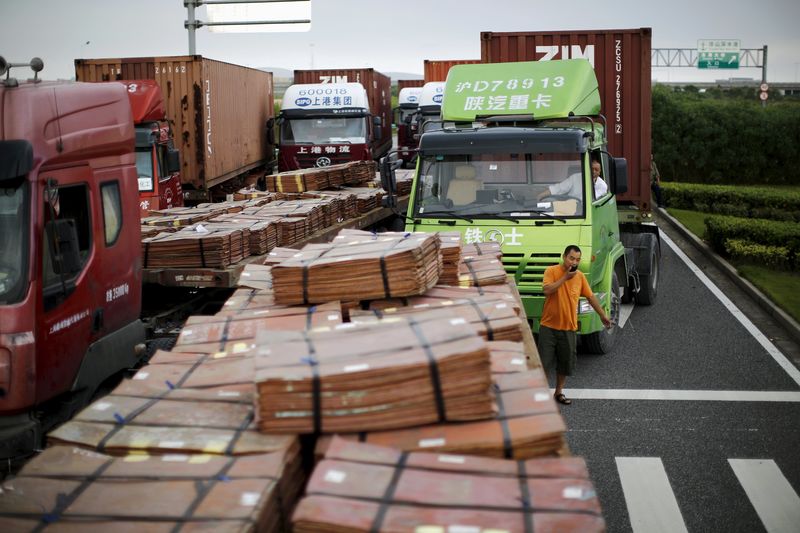By Xiaoyi Shao and Kevin Yao
BEIJING (Reuters) - China's exports in March returned to growth for the first time in nine months, adding to further signs of stabilisation in the world's second-largest economy that cheered regional investors.
March exports rose a blistering 11.5 percent from a year earlier, the first increase since June and the largest percentage rise since February 2015.
Fears of a hard landing in China even as policymakers press on with tough reforms to rebalance the economy have rattled financial markets, with investors eagerly hunting for tentative signs the economic slump may be bottoming.
Economists, however, warned that Wednesday's data was not evidence of stronger global demand as it was heavily skewed by base effects and seasonal distortions from the Lunar New Year.
And despite signs of green shoots for China, first quarter GDP data on Friday is expected to show the economy growing at its slowest pace since the financial crisis. Combined with tepid inflation, that is likely to keep Chinese monetary policy loose for some time yet.
Investors celebrated, nevertheless, with key Chinese stock indexes hitting three-month highs and the yuan firming, while regional stock markets and the Australian dollar
"China's foreign trade sector will likely improve from last year due to low comparables, but the improvement will not be dramatic, as the trends in external markets are not great," said Wang Tie Shi, economist with Industrial Securities.
The upside surprise comes after other March economic indicators hinted of slight improvements in the broader economy, although other surveys have shown intensifying downward pressure on wages and employment.
Imports continued to fall but less than expected, declining by 7.6 percent in dollar denominated terms and volumes of most major commodities, notably copper and iron ore, rose strongly.
That left the country with a trade surplus of $29.86 billion for the month, data from the General Administration of Customs showed, versus a forecast of $30.85 billion.
"I think we should focus on the better-than-expected imports growth rate, which means domestic demand is also recovering, driven by infrastructure investment and also the real estate sector recovery," said Ma Xiaoping, analyst at HSBC.
MOMENTOUS SHIFT
China's slowdown might not be quite as severe as first feared but its "momentous" shift from investment-led growth is still having a chilling effect on trade globally, the International Monetary Fund said on Tuesday.
The IMF estimates every 1 percentage point investment-driven drop in China's GDP, cut growth for the entire Group of 20 nations by 0.25 percentage points.
"Even countries that have few direct trade linkages with China are being affected through the Chinese slowdown's impact on prices of commodities and manufactured goods, and on global confidence and risk sentiment," the Fund said.
Regardless, overseas investors also appeared inspired by the trade data. MSCI's broadest index of Asia-Pacific shares outside Japan (MIAPJ0000PUS) added 1.7 percent and Japanese shares (N225) gained 2.8 percent.
Tony Nash, managing partner at advisory firm Complete Intelligence, which focuses on global trade flows, sees China's exports and imports stabilising over the next six months.
"As we close out Q2 and enter Q3, we'll see more stable trade data before starting to see sustainable, small rises in both sides," Nash said, adding data should be much less volatile in the second half as currencies and commodities stabilise.
NOT OUT OF WOODS YET
Economists polled by Reuters had expected March exports to rise 2.5 percent, after tumbling 25.4 percent in February - the worst showing since May 2009, and expected imports to fall 10.2 percent, based on weakness in global demand.
"Data across other Asian economies suggest that the headwinds in the trade sector remain," Zhou Hao, economist at Commerzbank (DE:CBKG) in Singapore, said in a research note.
Still, markets were relieved to see a surge in China's demand for commodities, with copper arrivals hitting a record in March and pushing up first quarter imports by 30 percent from a year earlier. Exports to key markets such as the United States and Europe also posted double digit month-on-month gains.
China's rising exports are also due in some part to a successful move up the value chain by mid-tier manufacturers.
"China's export sector is not losing competitiveness. In fact, China is increasing its share of other countries' imports, even though the global volume of trade has been sadly stagnant in recent years," HSBC wrote in a research note.
Even as Chinese factories have learned to build more expensive car components and wind turbines, they have been shedding capacity in lower-end sectors like textiles and outsourcing such production to neighboring countries.
Premier Li Keqiang said last week that China's economic indicators showed signs of improvement in the first quarter but a sluggish world economy and volatile markets were undermining gains.

The government is aiming for economic growth of 6.5 to 7 percent this year, following 6.9 percent growth last year - the weakest pace in a quarter of a century.